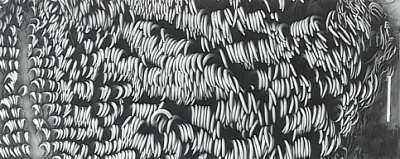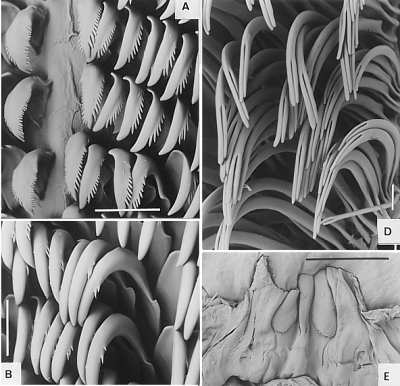

Rostanga bifurcata
- Radula
PHOTO
UPPER PHOTO: From Figure 9. Rostanga bifurcata specimen from Dampier Archipelago, Western Australia (WAM 109-87). Showing central region and whole right side of radula; Scale bar = 100 µm.
LOWER PHOTOS: From Figure 8. radular morphology of New South Wales specimens. A, B, Yellowish intertidal specimen from Jervis Bay, AM C144049; D-E, red sub-littoral specimens from Sydney, (AM C150028). A, Central and inner light lateral teeth; B, lateral teeth midwav out on right side; D, outermost right lateral teeth; E, buccal lining folded out to show jaw plates on either side of dorsal midline (anterior edge of each plate is towards bottom of picture). A-D, Scale bar = 30 µm; E = 1 mm. Photos: G. J. Avern.
[Rudman, W.B. & Avern, G.J. (1989). The genus Rostanga Bergh, 1879 (Nudibranchia:
Dorididae) in the Indo-West Pacific. Zoological Journal of the Linnean Society 96: 281-338.]
Return to Rostanga bifurcata
The innermost lateral tooth on each side has a wide triangular base and a wide recurved blade terminating in a pointed tip or cusp. On the inside edge of the blade below the cusp is a fringe of up to 16-20 short rounded denticles. On the outside edge there are often three to five long pointed denticles (and in one case 12), sometimes arranged on a slightly protruding flange (Figs A). The inner lateral teeth are similar in size to Tooth 1 but the blade is narrower and there are no inner denticles. On the outside of the blade the denticulation is identical to that of Tooth 1 (Fig B). By about one-third of the way out on each side the teeth begin to elongate and there is only one outer denticle situated about half way along the cusp (Fig C). At about three-quarters of the way out, the teeth have reached their maximum length and there is a rapid change in shape from a tooth with a long recurved blade, a pointed cusp and a small outer denticle, to a tooth in which the outer denticle is only slightly shorter than the cusp, forming essentially bicuspid outer teeth (Fig D). In some specimens the change from mid-lateral teeth with a small outer denticle to bicuspid outer lateral teeth can occur gradually over five to six teeth but in other cases the change is abrupt, adjacent teeth being quite different in shape. The jaw plates are not as well developed as in R. arbutus, the individual rodlets are more irregular in shape and only the outer three of four rows are free of the membranous layer covering the developing rodlets (Fig E).
The radular formulae of the following specimens are:
57.0.57 x 54 (+ 1) - 18 mm alive New South Wales (AM C144049)
93.0.93 x 70 (+ 1) - 29 mm alive New South Wales (AM C150028)
70.0.70 x 66 (+ 3) - 17 mm preserved New South Wales (AM C110041)
90.0.90 x 60 (+ 1) - 22 mm alive Queensland (AM C115992)
70.0.70 x 70 (+ 3) - 15 mm preserved W. Australia(WAM 109.87)
47.0.47 x 60 (+ 2) - 7 mm preserved Malaysia (AM C138161)
59.0.59 x 58 (+ 2) - 6 mm preserved Hong Kong (AM C139195)
52.0.52 x 58 (+ 1) - 7 mm preserved Hong Kong (AM C142190)
53.0.53 x 43 (+ 1) - 8 mm preserved Hong Kong (AM C139214)
57.0.57 x 65 (+ 2) - 10 mm preserved Hong Kong (AM C142191)
70.0.70 x 73 (+ 2) - 11 mm alive Tanzania (AM C150053)
Rudman, W.B., 2002 (February 5) Rostanga bifurcata - Radula. [In] Sea Slug Forum. Australian Museum, Sydney. Available from http://www.seaslugforum.net/factsheet/rostbifurad
